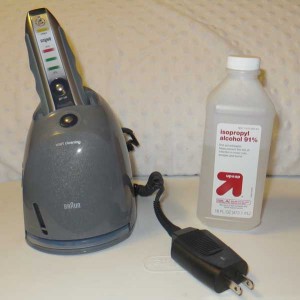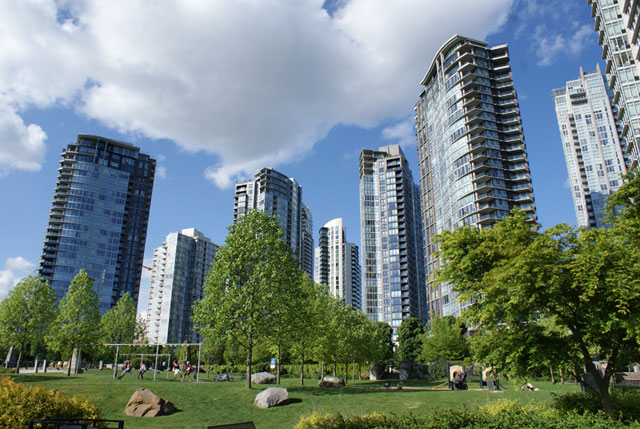Wondering how to make your own Braun shaver cleaner? Turns out it’s really easy

How to make your own Braun cleaning solution — just clean out the cartridge and replace with isopropyl alcohol.
It wasn’t long after the first Earth Day in the 1970s that a nascent environmental movement began growing from a tiny group of committed citizens and started spreading into the mainstream. I was in grade school at the time and looking back it was easy to see the very early stages of environmental enlightenment seeping into our lives.
I remember stickers (stuck on everything in sight, walls, poles, bus seats, you name it) shouting “Don’t be a litterbug!” I remember some hippie visiting our classroom with her acoustic guitar and teaching us Creedence Clearwater Revival’s “Rolling on the River” except the lyrics were changed to be “Rolling, rolling in pollution.” Then there was the guest speaker from the local energy company reminding us to take shorter showers. And of course our teacher spent a lot of time explaining why overpopulation was the biggest environmental problem of our generation (using math to show the compounding nature of population growth). A lot of those lessons stuck and while I don’t claim to live a sustainably perfect life, I do try to make reasonably good environmental choices.
One of the lessons that stuck with me was from a large school assembly. I think the presentation was from the local nuclear power plant (ironic given how awful nuclear power is for the planet). Anyway, the only takeaway I remember at all was that the speaker asked the audience which shaver used more resources: the electric version in his left hand or the disposable razor in his right hand.
Many of the kids shouted that the electric shaver used more resources, because it uses electricity. The speaker, enjoying tricking the kids with his question, explained that while the electric razor certainly did use power (he was from the power company after all), disposable razors had to be manufactured, wrapped, shipped, purchased then replaced. Over and over again. While I was still years away from the arrival of my first peach fuzz, I imagined a lifetime of disposable razors accumulating in a mountain behind me. It may have been one of the first moments that I became aware of the heartbreaking waste of our disposable society.
When my first soft, breezy whiskers arrived, I scraped together a few dollars and bought myself my first electric razor (like all my coming-of-age rituals, it was strictly DIY.) The tiny bits of blond hair were washed down the sink with the rest of my childhood. I used that trusty razor right up until the day I caught my stepmom using it on her nasty legs. (Ew)
In the decades since that horrible image was burned into my eyes like white fire, I’ve only owned maybe three or four other razors. I have never shaved with a blade. My current electric razor is just a few years old. Unfortunately in recent years I’m either seeing a sharp downturn in product quality or an increase in stubble strength as I reach middle age. Probably both.
On the other hand, one of the innovations I really like has been the advent of built-in cleaning mechanisms so your razor stays clean and sharp and ready to go. Before the self-cleaning versions came out, you had to delicately clean the cutter with a little brush and it never really got as clean as you’d want. Now you click a button and the next day, voila! clean razor! My current one is an older version of the Braun Series 5.
There is a problem, though. In the business world, there’s a famous saying that the money is in the blades, not the razor. It’s the classic replenishment business model. Printer ink is another great example. Give the razor (or printer) away for cheap and people will pay a lot more for the blades (or ink). Braun sells replacement cartridge refills but here we are again on the replenishment treadmill again! The price has really come down on these lately so it’s not as annoying as it used to be, but still! Plus here we are again with more plastic for the landfill.
The design of the Braun is also very annoying because the cleaning solution isn’t used up in the cleaning process. Most of it just evaporates! I tried putting the little cover over the cartridge holes but it basically had no effect on evaporation unless I sealed it on tight, which is not practical on a daily basis. (I’d say a cartridge maybe lasts two months when used normally.)
So I wondered: How can you make your own Braun shaver cleaner? Was there a way to hack my Braun to give me the sweet cleaning power I desire without the waste of buying replacement cartridges all the time? I looked around for bulk cleaning solution, but didn’t find much out there. I did find this Sandalwood Tree Cleaner that I have not yet tried, but may in the future just to see if I like it. But surprisingly the choices were pretty scarce.
I did finally try a solution that has been working well so far. It was simple and I’m very happy so far. Here’s what you do:
Once the razor solution is too low to do any cleaning, dump it out in the sink and rinse out the container as best you can. It doesn’t need to be completely spotless.
Then refill the container with Isopropyl Alcohol, inexpensive and available at any drugstore. I don’t know if the percentage makes a difference. I used 91 percent since that’s what we already had on-hand. I imagine the lower percentages might be gentler on the shaver. Don’t fill it up to the brim. Just fill it as full as the new ones, about two-thirds of the way full. Put the cartridge back into the device and you’re ready to clean. It does smell like rubbing alcohol but not so much that it’s overpowering. Adding some lemon essential oil would probably help, but I haven’t tried that so far either. The cleaning solution you buy also supposedly lubricates your shaver, which could be a problem long-term, but so far I haven’t noticed any difference. I may buy one new cartridge a year or so just so I can occasionally start with a clean one (it’s impossible to get all the hair trimmings out of a used cartridge). That might help if I did need some lubrication help. If it becomes a problem, I might add a little baby oil in as well to see if that makes a difference, but so far so good.
Before I tried my new homemade Braun shaver cleaner, I was thinking I was probably due for a new cutting head because the razor just wasn’t getting the job done. After enjoying a nice, crisp shave with this cheap solution, I think my cutting head is fine for awhile longer. So far I’m saving a little bit of money and the mountain of plastic behind me will be a little smaller because of it. And that alone makes it all worth it!
UPDATE 2/13/14: I founds some essential oil around the house so I dropped 3 or 4 drops into my reservoir to see what happened. OMG, it was the final piece! The Braun razor ran much smoother and was less abrasive on my skin. I’d say this mixture is AT LEAST as good as the store-bought version now!
Disclaimer: Alcohol is flammable. Be careful when refilling and using this technique. Also, I’m sure Braun does not recommend using anything but their own solution. You could severely damage your razor by using a product other than what the manufacturer recommends. Try it at your own risk. Also, links in this post are affiliate links so I may get a few pennies if you make a purchase.




